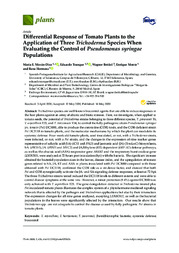Differential response of tomato plants to the application of three Trichoderma species when evaluating the control of Pseudomonas syringae populations.
Differential response of tomato plants to the application of three Trichoderma species when evaluating the control of Pseudomonas syringae populations.
Autoria: MORÁN DIEZ, M. E; TRANQUE, E.; BETTIOL, W.; MONTE, E.; HERMOSA, R.
Resumo: Abstract: Trichoderma species are well known biocontrol agents that are able to induce responses in the host plants against an array of abiotic and biotic stresses. Here, we investigate, when applied to tomato seeds, the potential of Trichoderma strains belonging to three different species, T. parareesei T6, T. asperellum T25, and T. harzianum T34, to control the fully pathogenic strain Pseudomonas syringae pv. tomato (Pst) DC3000, able to produce the coronatine (COR) toxin, and the COR-deficient strain Pst DC3118 in tomato plants, and the molecular mechanisms by which the plant can modulate its systemic defense. Four-week old tomato plants, seed-inoculated, or not, with a Trichoderma strain, were infected, or not, with a Pst strain, and the changes in the expression of nine marker genes representative of salicylic acid (SA) (ICS1 and PAL5) and jasmonic acid (JA) (TomLoxC) biosynthesis, SA- (PR1b1), JA- (PINII and MYC2) and JA/Ethylene (ET)-dependent (ERF-A2) defense pathways, as well as the abscisic acid (ABA)-responsive gene AREB2 and the respiratory burst oxidase gene LERBOH1, were analyzed at 72 hours post-inoculation (hpi) with the bacteria. The significant increase obtained for bacterial population sizes in the leaves, disease index, and the upregulation of tomato genes related to SA, JA, ET and ABA in plants inoculated with Pst DC3000 compared with those obtained with Pst DC3118, confirmed the COR role as a virulence factor, and showed that both Pst and COR synergistically activate the JA- and SA-signaling defense responses, at least at 72 hpi. The three Trichoderma strains tested reduced the DC3118 levels to different extents and were able to control disease symptoms at the same rate. However, a minor protection (9.4%) against DC3000 was only achieved with T. asperellum T25. The gene deregulation detected in Trichoderma-treated plus Pst-inoculated tomato plants illustrates the complex system of a phytohormone-mediated signaling network that is affected by the pathogen and Trichoderma applications but also by their interaction. The expression changes for all nine genes analyzed, excepting LERBOH1, as well as the bacterial populations in the leaves were significantly affected by the interaction. Our results show that Trichoderma spp. are not adequate to control the disease caused by fully pathogenic Pst strains in tomato plants.
Ano de publicação: 2020
Tipo de publicação: Artigo de periódico
Unidade: Embrapa Meio Ambiente
Palavras-chave: (hemi)biotrophic bacteria, Bacterial diseases of plants, Bactéria Patogênica, Biological control agents, Defense mechanisms, Fungo Para Controle Biológico, Pseudomonas Syringae, Systemic defense, Tomate, Tomatoes, Trichoderma, Trichoderma Harzianum, Trichoderma asperellum, Trichoderma parareesei
Observações
1 - Por padrão são exibidas publicações dos últimos 20 anos. Para encontrar publicações mais antigas, configure o filtro ano de publicação, colocando o ano a partir do qual você deseja encontrar publicações. O filtro está na coluna da esquerda na busca acima.
2 - Para ler algumas publicações da Embrapa (apenas as que estão em formato ePub), é necessário ter, no celular ou computador, um desses softwares gratuitos. Sistemas Android: Google Play Livros; IOS: iBooks; Windows e Linux: software Calibre.
Acesse outras publicações
Acesse a Base de Dados da Pesquisa Agropecuária (BDPA) para consultar o acervo completo das bibliotecas da Embrapa.

